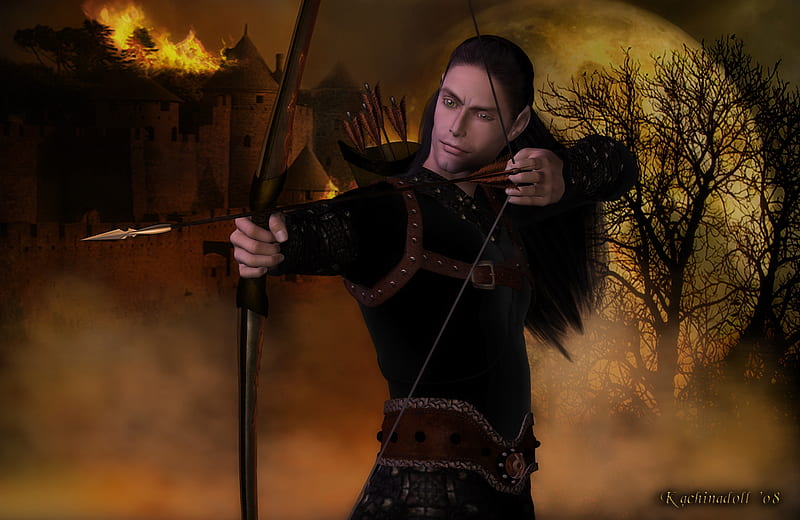
New Zealand Maori history tales of the little people[pixies],the Fairies, Ogres, Monsters, Etc...
The Maori had a distinct belief in the existence of fairies. Some of these were very like the European fairies—elegant, tiny people, fair-skinned and yellow-haired. Some were dark little elves, and some quaint deformed creatures, but they were all distinctly fairies, and not to be confused in any way with spirits or gods or ghosts.
It is said that when the Deluge swept over the earth some of those who escaped were a god-sprung little people, the fairies known as Pake-pakeha who dwelt in flowers and shrubs. This was the reason that white men on coming to New Zealand were named Pakeha, because they were fair and were supposed to have come from fairyland. Thus it was that their biscuit was called “fairy-pumice,” their sugar “fairy-sand,” etc., etc., by the natives. The fairies called Patupaearehe had distinct settlements. Their main place of residence was Coromandel Peninsula at the Thames, the part called Moehau, near Cape Colville, being particularly sacred to them.
Few natives dared to approach those shores, but those who did so had wonderful stories to relate of seeing fairy-forts made of interlaced supplejacks, and of finding plantations of gourds. If anyone attempted to lift one of these gourds it was found to be too heavy to move. The fairies played musical instruments, and their songs were often heard floating down from the hills. Fairies were angry if they heard a native singing at night, because they thought they were being mocked or insulted, and as they were a very tapu people, it was not to be endured.

A Maori would not wish to sing at night; he was prompted to it by his spirit (Wairua) as a warning of danger. I have often been warned by the Maori when camped in that locality never to move a yard from the camp at night, as I should be decoyed on by fairy voices and visions and would never return. Sometimes it is said that these fairies were brought to New Zealand in the Tainui canoe, and that a fairy-princess named Te Peri (a very curious coincidence with the Persian name for “fairy”) acted as a “directing-goddess” in the bow of that vessel.

She was a sister of Tainui, after whom the canoe was named, and who was buried at the foot of the tree from the trunk of which the canoe was made. The oldest traditions say that the Patupaearehe fairies where living here when the Maori came. They were divided into three tribes, the Ngati-Kura (Descendants of the Red One), Ngaki-Korako (Descendants of the Albino), and Ngati-Turehu (Descendants of the Dimly-seen).
It is curious that there is allusion to their fairness in the two first names, while the third, the Turehu fairies, are said to have had red hair. Some of the fairy-women's names are to be found in the genealogies of living Maoris who are proud of their uncanny lineage. The natives give a list of fairy dwelling places stretching from Cape Colville to Thames and Waikato.
A story is told of a Maori chief who long ago, when travelling by the sea, saw footmarks on the shore and these he felt sure were not those of human beings, so he hid himself till night hoping to see the fairies. When darkness fell, he heard voices crying, “The net here! The net here!” and just before dawn the fairy canoes appeared dragging nets heavy with fish to land. The fairies leapt ashore; they began to pick up the fish and thread them through the gills on cords so that they could be carried in bundles.
The Maori joined them and did the same but he pretended not to notice that they had knots on the ends of their strings while he had none, so the fish kept slipping off. They tried to help him, for the man was unusually fair-complexioned for a Maori, and in darkness they did not notice that he was not one of themselves. He delayed them so long in picking up his fish that at last daylight broke, and in confusion at seeing a man among them the fairies dispersed and dashed away to their own abodes, leaving the net behind.
It was this net which first became a pattern for the Maori, as they had no nets before this, but fished with hook and line only. In one account of this incident the fishermen are called Parau, the name of a mountain tribe; they used to steal down from the hills to net fish and from them the Maori learnt net-making. The Urewera tribe call their fairies Tiramāka.
Close akin to the ordinary fairy in appearance were “The Multitude of the Wood-elves” (Tini-o-te-Hakuturi). They were forest fairies who had charge of all the trees and shrubs. When Rata had felled a tree for his canoe without having uttered the necessary incantations to the Lord of Forests it was this tiny people that set the tree upright again and filled the chips into their places till it appeared as if untouched.

Another Maori chief was in a forest alone at night when he heard the voices of the wood-elves all about him. His retinue ran away, but the chief remained by his fire and was soon aware that he was surrounded by the “good people.” They would peep out from behind leaves and flowers when the fire died down, but when it blazed up they hastily drew back.
They sang a pretty song to him but he was greatly frightened and thought that if he offered them his ornaments, his breast-pendant of green jade and eardrop of the same precious stone, they might go away and leave him. So he spread out his poor little treasures, and the pixies accepted them. They did not take away the actual jewels, but only the spirits or similitudes (ahua) of them, and then the tiny visitors disappeared.
They appeared to be very small, fair-skinned, and light-haired; a merry people always singing. It is said that these wood-fairies taught mankind the art of carving and engraving. Rua was their pupil.
A fairy tribe known as the Karitehe haunted the forests of the far north; they also were a yellow-haired white-skinned people. Some of them lived in the Kauhoehoe caves. One of the ancestors of the Rarawa tribe surprised these fairies fishing, and lifting the corner of the net allowed the fish to escape. The fairies scented the presence of man and vanished. He afterwards succeeded in capturing one of the girls as his wife and after that the fairies abandoned the caves.
Before this the Karitehe would often seize Maori girls who were out gathering the tawhara blossom (flower of the kiekie, the Freycinetia) in the forest and the maidens were never seen again. It appears as if some forest fairies were mischievous and differed from the ordinary wood-elves. The child of a chief was carried off by a forest fairy named Te Tahae-o-te-Koraha (The Robber of the Open Lands).
The father of the child pursued and followed the sound of the little one's wailing, but could not overtake it. The cry sounded here, there, on this side, and on that side. All the men in the place heard the child crying and knew the voice, but it always came from a fresh direction, so then they knew it had been turned into a spirit (atua) and gave up the quest.
The water-kelpies (Pona-turi) were fairy people who lived under the water by day, but came out on land at night to sleep. They were destroyed by Tawhaki, whose father, Hema, they had killed. The bones of Hema they had carried away as trophies for their house of assembly. Tawhaki's mother had also been carried off by them, and she was retained as door-keeper and guardian of the house.
Tawhaki arrived at this house, whence his father's bones clanked a welcome, and his mother concealed him till the fairies had emerged from the water at nightfall, and were asleep within their dwelling. The hero's stratagem was to deceive them so long that when they awoke full daylight should surprise and slay these children of mire and darkness. So he carefully plugged up and stopped every orifice and chink of the house, and when the fairies called out to the woman, “Oh Guardian of the door, is it nearly daylight?” they were answered, “Not yet, not yet, sleep well.” The dawn had appeared and they were unaware of it, being in the dark interior, but when the sun had risen the hero opened wide the door and the bright rays streamed in. So the offspring of night and moisture lay dead upon the floor.
Very curious fairies are the tree-dwelling Nuku-mai-tore. They were said to have small heads with large waists and chests. They ate their food raw, as all supernatural beings did. One of them married a famous ancient Maori chief and voyager named Tura. He was dreadfully sorry to find that his wife, like all others of her tribe, would have to die when she was about to bear a child, as it was the custom to kill the mother in order to deliver the child by the Cæsarian operation.
Tura informed them that this was unnecessary, and his wife being delivered in mortal fashion felt great love and gratitude to her husband. (A variant of the legend says that by bathing in the Water of Life the mother could be restored.) A pretty little story is told of Tura and this fairy wife of his. One day when she was combing his hair she noticed white hairs among the dark ones, and she said, “Oh, Sir, what is this?” He told her that these were signs to men of approaching decay and death, at which the immortal wife wept bitterly. Hence the Maori speak of white hairs by the poetical phrase of “The Weeds of Tura.”
Wild men of the woods (mohoao or maero) are spoken of elsewhere under “Former Inhabitants.”
It has been mentioned above that fairies ate their food raw; they had an intense dislike to cooked food or the smell of it. A man named Ruarangi, who had been absent from home, found on his return that his wife had been carried off by a fairy (patupaearehe). After tracing her footsteps to the hills he went back and consulted a priest, who ordered all the people to leave their homes at nightfall; then he chanted an incantation to restore the woman's love to her husband. Then the priest said to her husband, “Go and meet your wife, and be sure when you see her to rub her over with red ochre (kokowai)”.
Now, the woman had felt the influence of the priest's spell, and all her love and desire were drawn towards her husband; so she deceived her fairy lover, and, going outside under a pretence, hastened to meet her lord. When they met he rubbed the sacred red colour upon her and her clothes, and together they hastened back to their home.
When the fairy abductor had become tired of waiting for his bride to return he went to look for her, and came upon her footmarks and those of a man, so, filled with anger, he gathered his elfish followers and pursued the fugitives. When, however, they reached the village they found all its posts daubed with red ochre, while the leaves used in the ovens were thrown on the roofs of the houses, and all the air was full of the odours of cooked food.
As the fairies were afraid of the tapu colour, and loathed the smell of cooked food, they dared not enter the village, and when the priest had recited a powerful spell against them they owned themselves vanquished and returned to their own place, leaving the married lovers in peace.
There is an account given of fairy people in the South Island in which it is difficult to disentangle myth from what might perhaps be legendary history. It is a well known theory in Europe that stories of fairies, elves, gnomes, etc., are traditional memories of peoples which once inhabited that continent before the ancestors of the present Indo-European race arrived and exterminated the occupant tribes.
If this is true it opens up a curious field of speculation in pre-historic Maori lore. The legend states that when the Maori hero Maui hauled up the land from the depths of ocean, he gave the land to The Old Woman (Kui), and her descendants dwelt thereon for ages. Then came a stranger people, the Tutu-mai-ao, who killed and inter-married till the children of Kui were annihilated, and Kui herself went down and lived underground. (She is incarnate now in a small insect* that lives in the cracks in dry ground.) After these again came a fairy people, the Turehu, who slew and inter-married with the Tutu-mai-ao till these latter disappeared.
Then to this fairy people came the Maori, who were also descendants of Maui by another line, and ten generations they had killed off or married the Turehu. They, the Maori, have existed here for 46 generations (about 1,000 years) that is to say 20 generations before the great migration from Hawaiki. The tribes of Kui, Tutu-mai-ao, and Turehu have all become “an indistinct people,” their voices are now only heard on the mountains. Indeed, in Maori, turehu has become a word meaning “to doze” and “indisnctly seen.”
Whatever of concealed truth there may be in this account is traversed by a legend which states that the South and was formerly inhabited by goblins, the Kahui Tipua, or “Ogreband.” These were gaints who could stride from ridge to ridge of the mountains, could transform themselves any shape they wished, and could drink up the rivers.

They hunted with two-headed dogs. An ogre-giant captured a woman and kept her as a pet, but after many months of his loathly embraces she escaped to her people. She knew the monster's habits, and returning with her angry brothers they blocked up with fern the mouth of the cave in which he resided, and then setting the mass on fire thus destroyed the ogre.
After these goblins had disappeared from off the earth, two tribes named puwai and Waitaha succeeded them and spread over the country: Waitaha increased till they were a very numerous people, of whom the proverbial saying is used “Waitaha, swarming like ants.” These were succeeded the Ngati-mamoe, who were exterminated (except some of the women who married the conquerors) by the Ngai-tahu whose possession lasted into historical times.
It is said that the first arrivals in the canoes from Hawaiki heard the fairies in their ghostly village, Te Tuahu-o-te-atua, playing different kinds of flutes and going through their songs and dances. A chief named Ihenga burnt them out of their stronghold at Rotorua, and they had to fly to the hills and forests.
Mention is made of a wild race, Te Aitanga a Hine-mata-roa, “The Descendants of Lady Long-face,” that dwelt in the forests of the South Island.
Besides the Kahui Tipua of the South Island there were other ogres and ogresses such as we read of in European fairy stories. Such a one was Houmea, who by the genealogies lived about 13 centuries ago. Her husband went to catch fish, and having returned, waited for his wife to come down to the canoe to take the fish up to the house, for it was her duty as mistress to see to the disposing, distribution, etc., of food to her family and retainers. Tired of waiting, he at last went up to the house and enquired the reason of the delay.
She answered that it was owing to the naughtiness of her two children, and going down to the canoe she greedily swallowed all the fish. Then she tore up bushes and trampled all over the beach, crying to her husband that a party of robbers had carried off the spoil. Her husband did not believe her at first, as there were no men living in the vicinity, but Houmea ascribed the robbery to the fairies. Her husband went out again next day fishing, but instructed the children to hide and see what happened on his return.
The events of the day before were repeated, and the children said to their father, “Houmea has eaten the fish.” Of course there was a domestic quarrel, but food had to be procured and the husband went away fishing on the third day. As soon as he was gone the ogress coaxed one of the children to her side and swallowed the child at one gulp, then the other was also swallowed. The husband on his return asked where the children were, and was answered that they had gone away somewhere.
Their father guessed that they had been devoured, so he examined his wife's lips and then recited a most powerful charm, upon the utterance of which the children emerged alive out of their dreadful mother's mouth. After this both father and children were afraid of the ogress, but the next time she complained of hunger they cried, “Open thy mouth wide!” and then with the wooden tongs took hold of a red-hot stone from the oven and thrust it down her gaping throat. So she perished, but became incarnate in the greedy shag or cormorant (kawau).
In long ago days a chief named Paowa came in the course of his adventures upon an old witch-ogress. This lady gave the stranger and his men some poor food and then went to the spring to get water for them, but on her way thither she fell under the power of a spell uttered by Paowa and could find no water.
When she returned she found her house burnt and her guests gone, so, calling up her dogs, she pursued the fugitives. They had sailed away out of sight in their canoe, but the witch, having put on magic armlets, waded out into the ocean and pursued. Finding that they were being overtaken, the men turned shore-wards and hid in a cave, blocking the entrance with stones and lighting a fire inside. The ogress tried to scratch her way in, but could not, so sat down outside the cave.
Paowa heated some large stones red-hot, and at the same time roasted some appetising food. He then cried out, “O, Lady! will you have a little food?” at the same time passing the roasted food through between the stones. The witch took the bait, and, smacking her lips, said, “That was very nice.” Paowa said, “Open thy mouth wide and you shall have some more.” She opened her mouth wide and the man then pushed a large red-hot stone down her throat, so she fell down and died. When Paowa went out and sought to take away the armlets flashes of lightning came from her armpits, but nevertheless he took the charms away and started homewards.
Pou-a-hao-kai was a cannibal ogre destroyed by Rata throwing red-hot stones down his throat. When the last one was thrown the monster burst open, and then were seen the canoes and men which he had swallowed.
“Childe Ronald to the dark tower came;
His word was still, 'Fee, fo and fum,
I smell the blood of an Englishman.'”
But the hero had suspended a noose in the doorway, and as the ogre entered to find his victim he was snared and killed.Smell! Smell! Odour! Odour!
Closely connected with the fairy and ogre stories are the legends of monsters, lamias, water-goblins, gigantic birds, etc. One of a Lamia or serpent-woman is related concerning a chief named Ruruteina, who was returning from an expedition with his brothers. Wishing to get some fire, he went up to a house that was inhabited by a female named Variegated Reptile (Ngarara Huirau).
She asked him his mission, but when he wished to go encircled him with her tail and kept him with her. Her attendants placed food before him, but it was disgusting from being polluted with the scales of the creature's body, and upon Ruru making some contemptuous remark about the viands the attendants advised him to escape.
The Lamia overheard this, and attacked the servants, one of whom hid within a stone and the other in a carved wooden figure. In the confusion Ruru got away. His brothers and he then built a strong house “with nooses and figures of men on it,” and in this house Ruru hid himself. His friends and brothers called on the gods to help them, and soon Madame Reptile made her appearance. She put her tail round in a circle and caught Ruru, saying, “You thought you could escape me.”
He engaged her in conversation while his brothers were piling wood and combustibles round the house, and when this was finished they set it on fire so that the house was soon full of smoke. Ruru escaped by the little window-opening, but the Lamia was burnt up. Every scale of hers that jumped out of the fire was thrown back into it, except two, and one of these became the origin of the Para-tawhiti fern (Marattia salicina).
A somewhat similar story is told of a man named Tua, who was left behind in Tahiti when the “Mataatua” canoe set out, and who wished to make a canoe, so he felled a tree and went home, but on returning in the morning found the tree set upright again and apparently uncut. The same thing occurred three times, and then Tua waited to see the persons that set the tree up again, precisely as Rata did (in a legend already related) when the wood-elves set his work at naught.
While Tua was waiting he was perceived by a huge reptile (ngarara) ogress, who pursued and captured him, carrying him off to her den as her husband. They had a child, and then Tua was allowed to return to his friends. The child grew up and wished to see his father, so journeyed to his parent's home and then struck the sacred drum in the middle of the village.
The inhabitants were going to kill the boy for his sacrilege, but he said, “Only Tua must kill me.” When Tua came the boy told him about the tree being felled and its being replaced upright. When he reached the part of his narrative which spoke of the tree being set up for the third time, Tua said, “It is enough; you are my son,” for he did not wish people to know that he had once lived with a reptile.
Of course with a people so superstitious as the Maori there were stories current of the existence of all kinds of monstrous or abnormal creatures besides those that may be properly called gods, spirits, fairies, ogres, etc., etc. Prominent among these were the demons or goblins (tipua or tupua) who were not always visible in a frightful or terrifying shape but assumed the appearance of ordinary creatures or things; still they were ready at a moment's notice to shed their malign influence around.
Of such was a cormorant that haunted a canyon in the Tuhoe country, and whose appearance always brought (or betokened) disaster to the Ngati-whare tribe. It flew over the village three days before a death occurred. There was a lake on the summit of the mountain, Maunga Pohatu, in the same part of the country, and this lake was a demon dangerous to approach. Again, a stone tipua was to be found at Mangaohoa and if you ventured near it without repeating a certain charm you would be deluged with rain.
At Titiokura was a tipua stone in the shape of a canoe, and at Rangitaiki River was a tipua log of totara wood above which no eel would pass. At Opunga, in the Waihui stream, and at Muru-waka, in the Turanga River, are local demons in the shape of stones. There was a demon log or tree named Tutaua which floated on Waikare-Moana Lake.
It sung as it went, in a voice like the wind whistling. If it drifted ashore and anyone cut a chip from it, the log would disappear the next night. Generally it drifted, ever floating hither and thither, by night or day. A rock in Waikare-Moana is called Te Hinaki o Tutaua (“the eel basket of Tutaua” the log demon) and was a tipua, for if a north-west wind blew, and the rock was stroked with the hand, a south wind would spring up; this side of the lake is sheltered from the south.
A shrub of koromiko (Veronica) grew in a place near Taupo once used as an oven for cooking men. Two celebrated chiefs were cooked there five generations ago, and the shrub has been there ever since, never altering in appearance. It is a tipua of the spirits of those two chiefs. On the Kaingaroa plains near Taupo there were cabbage-trees (ti) known as Tihaere.
These were goblin trees which looked as if growing, but if one attempted to approach them they would shift position and elude the attempt. They were enchanted maidens turned into wandering trees as a punishment for laughing at their mistress.
It is an evil omen to see them. Not far from Gough's Bay, in the South Island, there were enchanted black-pine trees (Te Aitanga-a-Hine-mate-roa). Not far away were enchanted cabbage-trees (Ti-a-Tauwhetuku) that moved about and embraced each other like human beings. With these was a tree of the Broad-leaf variety, also under spell; its name was Te Papa-tua- mau-heke.
A giant cuttle-fish (wheke) lay in Cook's Straits; it pulled down canoes. It was killed by a band of heroes from Whanganui. The tame whale Tutunui was the favourite ocean-steed of Tinirau the god of fishes, and it was destroyed by Kae the cruel priest. A gigantic eel-demon inhabited the Piako Swamp, south of Auckland. Its upper part was human but the lower half that of an eel.
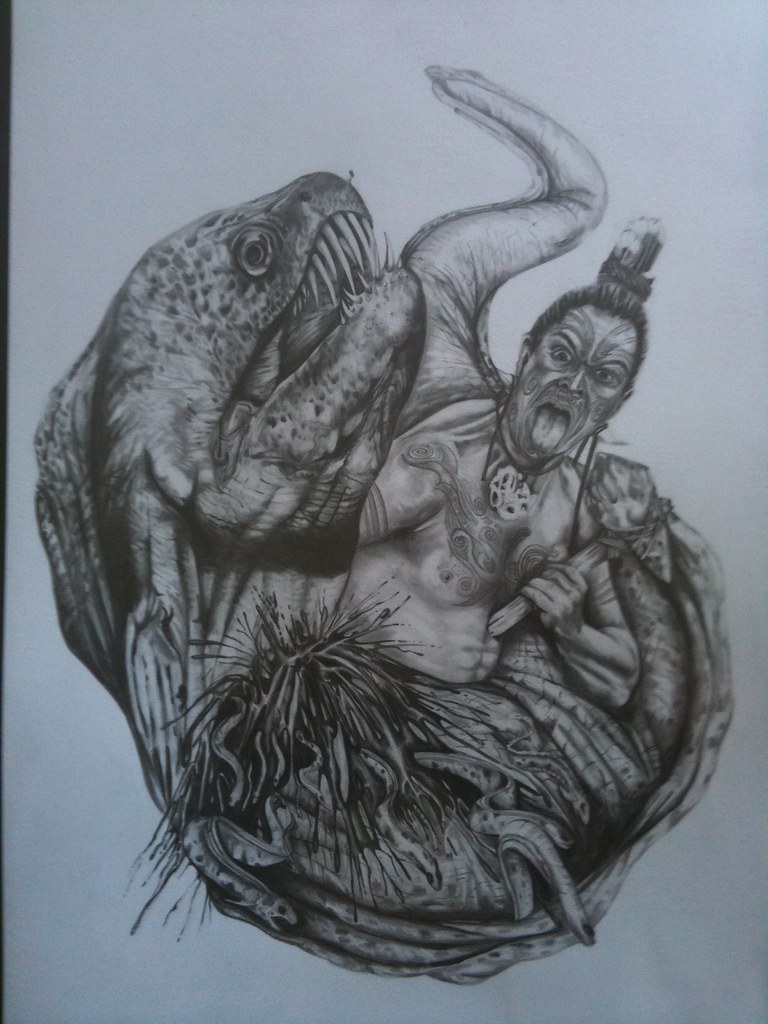
There is said to have been a gigantic eel (tuoro) that did not live in the water but dwelt in the open fern and grass country; it was very ferocious, especially to men. It could not pass ashes or fire, so that when natives were attacked by it the only way to escape was to set the fern on fire and so burn the creature, or else to get on to a place where the fire had lately passed. It made a noise like a roaring bull.
One cannot read of such a belief as this (and considering the above written stories of the serpent-women) without fancying that though New Zealand was probably always without snakes of any kind the Maori has brought legends concerning great ophidians from far-off lands.
There is a description of the slaying of the demon Matuku by means of a snare and it ends thus, “Then Matuku struggled! Struggled in vain! What could he do with the rope choking his throat? He lashed his tail; the moisture came forth from his belly.
It is in the tail of that kind of beast—such as Matuku—the strength lies; for, if it be cast up on a tree it cannot be loosened, but the body will be drawn up after it; Such was Matuku.” It reads very like the far-off tradition of a python. We shall refer to this subject farther on in the description of water-goblins (taniwha).
In the South Island there is a tradition concerning a monstrous bird of prey, the Pouakai. It is said that one of these birds had its nest on a spur of Tawera mountain. When it attacked human beings its downward rush was so fierce that none could withstand its fury, and its victim was carried off to be devoured at leisure.
At last a hero appeared who resolved to destroy the ferocious bird, so he made his men, 50 in number, form a network of young trees laid over a deep hole, and in the hole the 50 men armed with long spears were hidden. The hero himself went forward to lure the bird to the place of concealment. This he succeeded in doing, and then, saving himself from attack by swiftness of foot, he too took refuge in the hole, just reaching shelter as the monster swooped downward.
As the bird (the roc?) violently attempted to reach him with its claws through the network of branches the spears of the 50 were plunged upwards between the saplings into its breast, and after a desperate struggle the great man-eater died.
Sometimes the story is varied with an account that a strong block-house was erected and in this the band of deliverers seated themselves. When the bird came it was assaulted and killed with stone axes.
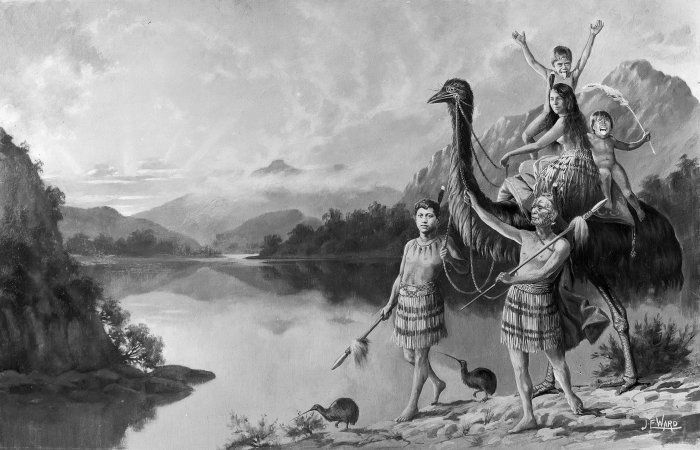
There were enormous birds living in Hawaiki, and one of these was used as a means to bring a chief named Pou (Pou-ranga-hua) to New Zealand. He loaded up the bird with two magic spades, together with two bags of sweet-potatoes, and set out. There was living on Hikurangi Mountain a terrible sorcerer named Tama-i-waho, whose evil influence could only be escaped when the sun was shining full in his face; only then could the terrible place be passed.
The bird and its rider slipped past the mountain just at the right time, when Tama's eyes were dazzled, and then the bird shook itself as a sign that Pou should dismount. Pou was a selfish man and insisted that the bird should carry him further, although he knew that it would be an evil thing for the bird, as it would have to repass the place after the sun was gone.
Pou, stooping down, reached under the wing of the bird and pulled out five plumes, which he cast into the sea, and one of these plumes became a tree (kahika) that grew and bore fruit out in the ocean. One of its branches was cast ashore by the tide and it took root, becoming the great forest of Makauri, between Makaraka and Te Waerenga-a-hika. Pou made the bird bear him to his home, and then, when it was returning, it came under the evil power of the wizard at Hikurangi and was destroyed; but Pou planted the sweet potatoes, and from this seed came all the cultivations of Turanga. The Tuhoe tribes have traditions of a great bird named hakoke that existed in ancient times but has long been extinct.
Perhaps this is a form of the general native belief as to the huge hokioi, a bird of prey, large as the moa, but with many coloured feathers and a bunch of red feathers on its head. The bones of a very large raptorial bird, the Harpagornis moorei, have been found in New Zealand.
Again turning from birds to reptiles, or rather to myths of reptiles, we encounter the wonderful taniwha. The word is generally applied to a water-monster, amphibian, or supernatural creature. Even a great chief, one whose power was enormous, and whose fame was terrible, was alluded to as a taniwha. (Waikato taniwha rau!! “Waikato of a hundred chiefs!”)
The name was also applied to a kind of large shark. Some of the taniwha loom large as beings of pure myths, others are spoken of so circumstantially as being lizards that most of the early settlers in New Zealand were persuaded that some ferocious creature of the alligator kind inhabited the lakes and rivers of the Colony.
Taniwha have often been reported as having been seen since the occupation of the country by Europeans, but in most cases these have been found to be seals that have come up the rivers a long way from the sea. They have been seen in the River Waikato as far up as the town of Hamilton, and in the Manawatu River at Dannevirke.
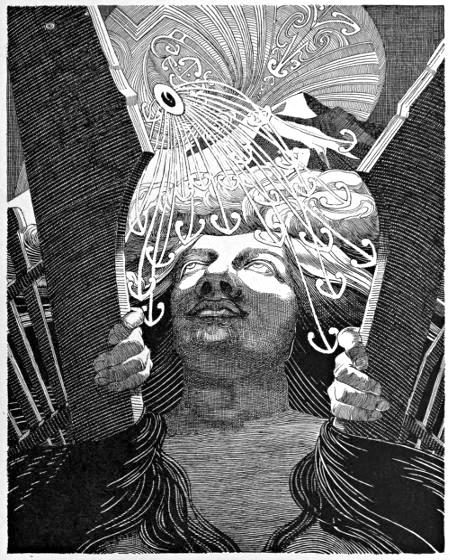
So chanting, the hero drove the magic staff through and through the sides and belly, widening the hole till it was large enough for him to emerge through. In strong convulsions the taniwha yielded up its life, and no more were the river canoes with their crews devoured.“Rage great fish, and lash your sides,
The cravings of your hunger
Methinks should now be fully appeased,
For have you not (within you) the potent Aokehu?”
A huge reptile named Tu-te-maunga-roa lived near Taupo Lake, and was slain by Te Uru-waewae. Ruai-moko-roa was another of the species and was killed by the sons of Tu-Wharetoa. At the mouth of the Manukau Harbour lived the man-devourer Kaiwhare. It dwelt in a cave, the entrance of which was six fathoms below the surface of the sea. Down into this noisome den dived a hero-chief resolved to slay the monster, and this feat he achieved, striking such terrible blows with his club, made of the bone of a whale (paraoa), that the destroying creature soon yielded up its life.
Another taniwha named Ureia visited the same locality and was taken in a goblin-house and killed, but its proper haunt was Hauraki (the Thames) and it was decoyed to the place where the traps had been laid. Arai-te-uru and Taungeri (or Nuia) were the two guardian taniwha of Hoki-anga Bar. Arai-te-uru was a female and was the mother of many other celebrated taniwha; among them being Waihou, Orira, Maunga-muka, Ohopa, and Wairere.
Taungeri was the dominant partner, but sometimes Araite-uru would break bounds and start on her own account up the river, overturning canoes and eating the eyes of those thus drowned, this was “her mark.” A remarkable rift may be seen in the glen below Marokotia, between Cape Kidnappers and Castlepoint. This was caused by a taniwha named Hine-huarau who burst away, tearing the country through till it reached Wairarapa where it was killed by a chief named Tara.
It is perhaps another tradition concerning the same creature which relates that a taniwha named Te Ngarara-huarau arrived at the mouth of the Pahaua River, Wairarapa, and went up that stream. Some of its scales remained in a cave and turned into lizards (tuatara). Companies of people were destroyed by that reptile before it was slain by a chief, who ordered his people to partially cut through the forest trees by the side of the track, to cut them not quite enough for them to fall, but so that at another blow of the axe each would fall.
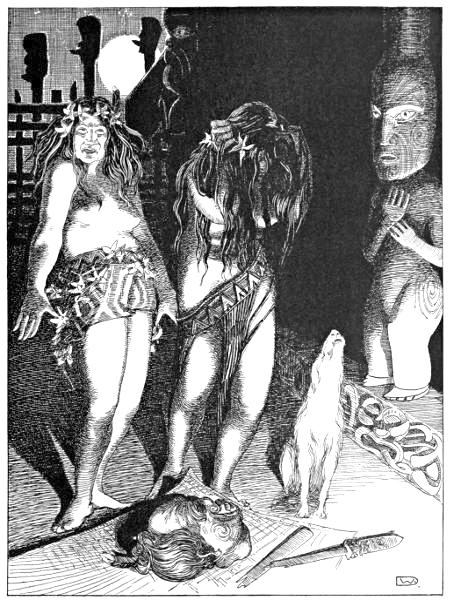
The priest took a dog, repeated charms over it, then it was sent to the cave of the taniwha to bark. The reptile pursued the dog, but when it came to the place where the trees had been chopped at it struck the trees and its immense bulk made the trees fall.
It wriggled and twisted with mighty struggles but the weight of the heavy timber killed it, and the destroying tribe, that of Ngai-tara, rejoiced. Puku-tu-oro and other marine monsters sprang from the body of Tuna the Eel-god when that deity was slain by Maui. Ocean taniwha often hovered about canoes, having in their charge some celebrated chief on board the vessel, and for whose safety they were bound to provide.
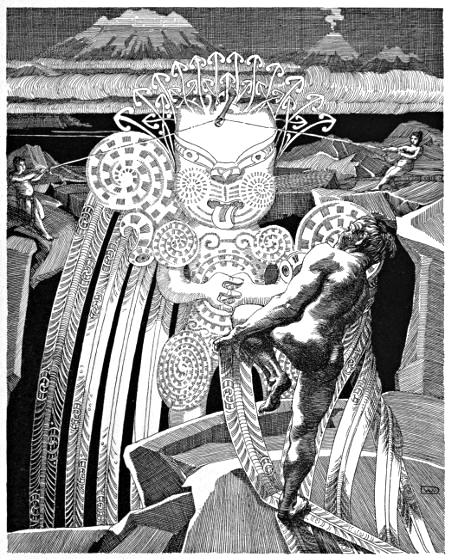
A monstrous reptile named Te Kai-whaka-ruaki once dwelt in the Parapara stream near the place where Collingwood, Nelson, now stands. Hosts of men were devoured by this beast; whatever the number of a party of travellers, whether fifty or a hundred, none escaped. There was a famous seal-hunter, Potoru, whose boast it was never to use a weapon, but to slay with his mighty hands. He formed a war-party of 340 men and posted them, with spears, where they might attack in two parties. Then the hero advanced into the sea to decoy the creature forth.
Soon great waves were seen as the reptile parted the ocean in its advance, and the man drew back until the water was only waist-deep, and at last only knee-deep. Then the invisible fist was raised and fell on the snout of the taniwha, driving it to one side.
Quickly the monster twisted and snapped, beaten from one side to the other by repeated blows. Once the champion missed his stroke, the wide-distended jaws received him, and he vanished alive into the vast interior of the ocean-goblin.
The main party of warriors attacked, first one side, then on the other, the taniwha lashing with its huge tail till a hollow a fathom deep was made in the ground. The spears were too numerous and their bearers too brave for the fight to have any conclusion but one and soon the enormous bulk was extended still in death.
When its belly was cut open there were large stores of mats and weapons and quantities of human remains still undigested. Thus was the scourge of the district removed, but gallant Potoru had given his life for the result.
Taniwha were not always water-dwellers, but were sometimes found on dry land. The best known of these is Hotupuku, a lizard or dragon that lived on the track between Taupo and Rotorua lakes. For a long time its existence was unknown, until travellers who journeyed by that way were found never to arrive at their destinations.
At last the reptile was seen by some who escaped. They related how, when it left its cave, and when they saw its lofty crest and the dreadful spines and spears of its body, which were raised like ridges of waves at sea, they had all trembled and fled. Warriors gathered together 170 in number, and set out to encounter the dragon.
Having arrived near the den, they set to work to plait ropes—great ropes, flat, and round, and double-twisted, fine-stranded, and of many other kinds. These they made into snares and nooses set cunningly along the path, and then sent their swift-footed ones to entice the monster forth. Soon it sniffed the smell of men and came out, its awful tread resounding like thunder.
Farther and farther back ran the enticing men, pursued even to the place of snares. Then cried they, “Haul away! Pull away!” and the demon was snared by its middle. The tail lashed furiously about, but nimble warriors dashed in with their spears, stabbing and piercing, while they leapt to avoid the strokes of the thrashing tail.
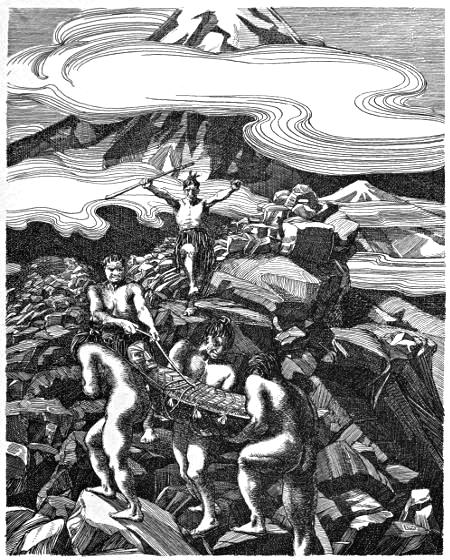
The tail was snared and lashed to posts firmly driven in, and the terrible head received attention, a party of men on one side rushing in and pounding with axe and club, and then their friends on the other side doing likewise. The bulky creature was pounded from end to end; at last it yielded up the ghost.
Its aspect was that of the tuatara lizard (Sphenodon punctatum), its size that of the sperm whale. When its slayers cut up the carcase with knives edged with sharks' teeth there was found therein the bodies of human beings, mats and weapons. The fat of the carcase was melted up and used by the victors with their food. Thus they devoured their enemy in true New Zealand fashion.
We have referred above to the apparent legendary knowledge among the Maori as to great serpents, and considering the last related story it is hard to believe that, if not in New Zealand then in some other country, the Maori has been unacquainted with some huge saurian and its capture.
The account of the snares, the decoys, etc., seem very circumstantial, and hardly to be imagined if the New Zealand fauna, harmless and small, were the only bases of tradition. Tradition adds to the story of Te-Kai-whakaruaki that a dog was made to bark in order to lure the reptile forth, as in crocodile-haunted lands dogs are similarly used.
Probably the legend is far older than the migration to these islands, for an identical story of the capture of a great lizard (its spines, the snares, etc.) was related to Marriner in the Tonga Islands, so is probably a joint possession of the Polynesians before their dispersion. As the Tongan language is perfectly unintelligible to a modern Maori that dispersion must have been decades of centuries ago.
The men who had killed Hotupuku started to destroy another taniwha named Pekehaua that inhabited a place called Te Awahou in Rotorua District. It was a man-killing and malignant creature. The hunters prepared a great trap of basket-work, and some twisted ropes wherewith to snare the monster in its pool.
They lowered the trap with many charms and spells which caused the spines and crest of the taniwha to become soft and flaccid. One heroic adventurer went down to the depths of the dark watery chasm and boldly bound a rope around the beast while it was hypnotised by the incantations, then he signalled those above to haul up.
The spells for hauling up, and making heavy weights light, were recited, the taniwha was pulled to the surface and beaten to death. As in the others, were found bodies, mats, weapons, etc., and so also the tomb of the taniwha was the all-devouring throat of man.
A taniwha named Rongo-te-mauriuri dwelt in a lake on the summit of Maunga Pohatu in the Tuhoe country. Another (a variety of the Tuoro or eel) lived in Otara Lake on the same mountain, and it was this latter monster that formed the valley of the Waikare stream in ancient days.
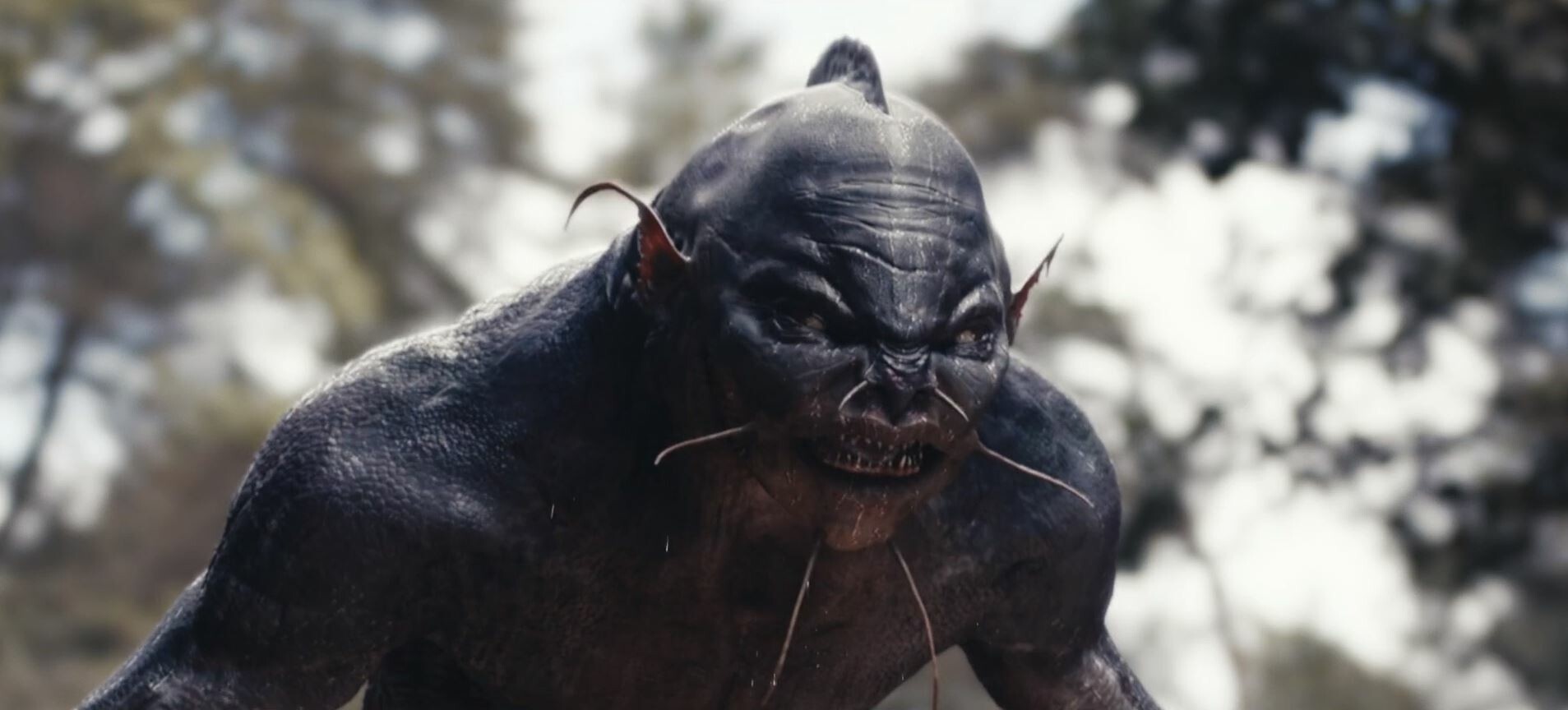
The giant reptile Horomatangi lived in the centre of Lake Taupo, and a human taniwha, Atiamuri, was his friend. The human goblin played decoy for the other. They were greatly dreaded and no canoe would pass from north to south or from south to north directly from Tokaanu to Tapuae-haruru or vice versâ. A variant of the common taniwha was one with wings that appeared near D'Urville's Island, Cooks Strait.
It was attempted to be killed by two brothers, one of whom, a swift runner, acted as lure. They dug a pit and took refuge in it when the monster attempted to enclose them with its wings (arms? tentacles?). The taniwha made the earth shake and closed up one side of the pit with its huge claw, but this was cut off by its assailants, then it tried to force in the other claw, this also was cut off. When it thus became defenceless it was slain. The belly was full of men and women heaped up—some of the women had children with them.
At Tikitapu, Rotorua, a monster named Kataore was kept as a pet by a chief who believed that his sacred power had made it a miracle of peaceableness and gentleness, as it always so showed itself to him and his men when they went to feed it. In reality it devoured men, and travelling parties were exterminated by it. So, recourse was had to the brave and that had exterminated Hotupuku and Pekehaua.
The warriors brought their ropes and weapons and also some pleasant enticing food. Their priest recited charms to discover the whereabouts of the taniwha. They left the forest and tried the lake, but in spite of the most potent incantations not a bubble broke the surface of the water. Just as they were in despair there was heard a roaring as of a tempest from the overhanging precipice at Moerangi, and the men said, “Its home in the stony cliff.”
They uttered powerful spells to make the monster weak, while their bravest men peered into the cave. There sat the noxious beast, with fearful eyes like the moon when rising, but flashing and glinting like clear greenstone. Brave hunters! they slipped the ropes and snares over neck and forelegs, doubly sure were the knots and nooses made.
Then those outside, the band of 170 men, hauled away, and the taniwha reared and plunged till the ropes cut deep into its body, but the armed men came and battered it to death with many blows. To work went the wooden knives with their sharp rows of sharks' teeth. It was a harvest-time. When they reached stomach there were bodies of men, etc. (as usual in these tales) and the victors buried the remains of their friends in the ground, and their enemy in their ambulating cemetery.
A man named Tu-heitia, who had been killed by his brother-in-law, went into the sea and became a taniwha. He took up his place in the Waipa River above its junction with the Waikato. He was as large as a whale and resembled a whale in appearance. Tamatea, by means of charms, turned some of the brands from his fire, and also his dog, into a taniwha. A block of stone supposed to be a taniwha is at Mokau, and to this stone barren women resorted when they wished to become pregnant.
The magic-houses for catching taniwha were erected on great rafts built of bulrushes (raupo). No wood was allowed to be used in making the house; it had to be entirely woven of reeds, flax, or grass. The flesh of a seal was placed within the house and the raft was then moored in the current of a river. When the smell of the seal's flesh had attracted a taniwha the uncanny creature would climb up on the raft, and the goblin-killers would, after uttering a prayer to the god Rongo, go and kill the leviathan.
~*~
I found this article extremely interesting as it mentions the area around where I live for starters, then it just got better the further I read on, the Maori are still to this day very superstitious about these creatures in our native bush, the Taniwha especially is still blamed for disasters & accidents including drownings in any body of water & they go out and bless the site where these things happen and no one is allowed to swim in a river or lake or ocean for a week or so after the accident or the police will prosecute you for a breach of their cultural rites or something to that effect, I'm not 100% sure what the charge is, but you will be charged by law enforcement, as its considered highly disrespectful to their belief structure..
I've heard many a tale of the little people told by the elders on the Marae [meeting house],one elder [kaumātua] there who told me his awesome stories of being with them as a child & so he was also highly interested in my photo I showed him of them that I'd taken & he told me I'd obviously been blessed by them to have seen them.. as most dont show themselves that easily, he liked the one I called the bow & arrow hunter the best ,as he said he resembled a maori warrior wearing a cloak of reeds...so they are not going to be forgotten about in any hurry.
~Vlada
Here is the original photo I showed the kaumātua of some [little people] pixies that I've seen myself..there is a cloaked Wizard & a woodland Archer carrying his bow & arrows over his shoulder in a woven reed basket of sorts ..
This is the Original photo below can you see them yourself?...
Now here below is a cropped photo off it & I've marked them both to show you...the cloaked woodland wizard in robes wearing a dark belt with his hat hes holding his staff beside him & the Archer with scruffy black hair below it with his moss top and woven basket of arrows over his shoulder & bow in his hand..
© 2025 Created by Tara.
Powered by
![]()

